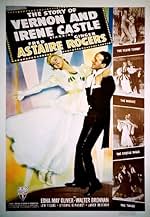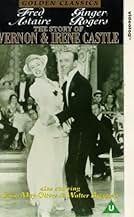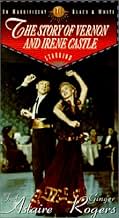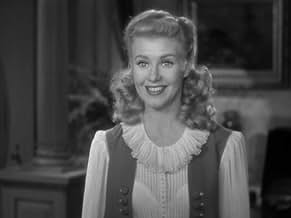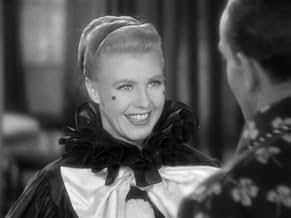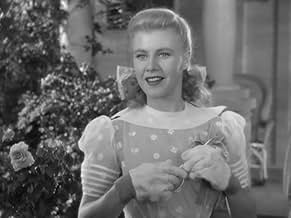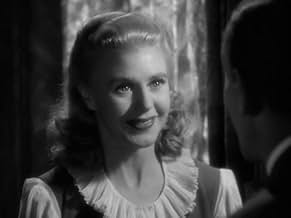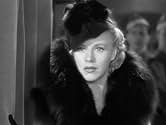VALUTAZIONE IMDb
6,9/10
2859
LA TUA VALUTAZIONE
Aggiungi una trama nella tua linguaThe story of the dancing team who taught the world to two-step.The story of the dancing team who taught the world to two-step.The story of the dancing team who taught the world to two-step.
- Premi
- 4 vittorie e 1 candidatura in totale
Buzz Barton
- Undetermined Secondary Role
- (non citato nei titoli originali)
Max Barwyn
- Waiter - Cafe de Paris
- (non citato nei titoli originali)
Trama
Lo sapevi?
- QuizIrene Castle served as a technical advisor on the film. According to Ginger Rogers, Castle disliked every costume that she wore and deemed them to be anachronistic. Due to censorship restrictions, Rogers' costumes evoked late 1930s fashions rather than the more daring styles of Castle's 1910s era. After Rogers refused to cut her hair to portray the bob hairstyle that Irene had popularized, Castle became more displeased. The studio silenced Castle's protests with an additional payment of $5,000.
- BlooperWalter, the Footes' and later the Castles' servant / factotum was, in reality, a black man.
- Citazioni
Irene Castle: I thought you could be a first dancer, a very beautiful first dancer because you are a beautiful dancer but you're so smug and conceited that you can't see any further than your funny nose!
- ConnessioniFeatured in Fred Astaire: Puttin' on His Top Hat (1980)
- Colonne sonoreOnly When You're in My Arms
(1939)
by Con Conrad - Herman Ruby Bert Kalmar
Sung by Fred Astaire (uncredited)
End dance: Fred Astaire (uncredited) and Ginger Rogers (uncredited)
Recensione in evidenza
This was the last of the Astaire and Rogers films at RKO (they would reunite at MGM for "The Barkeleys of Broadway" [1949]), and represents the studio attempting to find a new way to make the duo popular. It's hard to believe, since the pair have become legends in Hollywood musical history, but by the end of the 1930s audience interest in Astaire and Rogers seemed to be ebbing. Consequently, this film feels *very* different than the rest of their films.
This is not a story of boy meets girl/boy dances with girl/boy loses girl/boy chases and chases girl/boy gets girl and dances with her again. There aren't a ton of the whimsical oddball comic supporting players. And--steady yourself--there are very few full-out major musical numbers. There is no stunning score of songs by Irving Berlin or the Gershwins.
This is because this is a musical biography about the Astaire and Rogers of the previous generation. Hence, the duo are asked not to dance in the manner that made them popular but in the manner that made *the Castles* popular, and to music that *that* couple danced to. Often, when the two dance, we are interrupted by various plot points (ie., cutting to other characters talking instead of keeping the camera on the dancers). One of the few moments where we are able to enjoy them completely is a montage sequence showing the Castles becoming the toast of the nation (with Astaire and Rogers literally dancing across a giant map of the U.S.)
The other major musical number is a solo: Ginger Rogers singing "The Yama Yama Man." Astaire was about to end his contract at RKO, but Rogers still was under contract--so the studio is plainly more interested in trying to build up Rogers for a solo career, and the film indicates this (Rogers' solo, the emphasis on her clothes and hair, etc.) Meanwhile, the film also indicates a growing awareness of the coming war, by dealing with Vernon Castle's enlistment during World War I--one of the first times Astaire had donned a uniform for the cameras (something he would do a *lot* in musicals for the next 5 years).
All in all, it's not what one usually expects from an Astaire and Rogers film, and thus suffers in comparison to "Top Hat" or "Shall We Dance," but still retains a charm and personality nonetheless.
This is not a story of boy meets girl/boy dances with girl/boy loses girl/boy chases and chases girl/boy gets girl and dances with her again. There aren't a ton of the whimsical oddball comic supporting players. And--steady yourself--there are very few full-out major musical numbers. There is no stunning score of songs by Irving Berlin or the Gershwins.
This is because this is a musical biography about the Astaire and Rogers of the previous generation. Hence, the duo are asked not to dance in the manner that made them popular but in the manner that made *the Castles* popular, and to music that *that* couple danced to. Often, when the two dance, we are interrupted by various plot points (ie., cutting to other characters talking instead of keeping the camera on the dancers). One of the few moments where we are able to enjoy them completely is a montage sequence showing the Castles becoming the toast of the nation (with Astaire and Rogers literally dancing across a giant map of the U.S.)
The other major musical number is a solo: Ginger Rogers singing "The Yama Yama Man." Astaire was about to end his contract at RKO, but Rogers still was under contract--so the studio is plainly more interested in trying to build up Rogers for a solo career, and the film indicates this (Rogers' solo, the emphasis on her clothes and hair, etc.) Meanwhile, the film also indicates a growing awareness of the coming war, by dealing with Vernon Castle's enlistment during World War I--one of the first times Astaire had donned a uniform for the cameras (something he would do a *lot* in musicals for the next 5 years).
All in all, it's not what one usually expects from an Astaire and Rogers film, and thus suffers in comparison to "Top Hat" or "Shall We Dance," but still retains a charm and personality nonetheless.
- SGriffin-6
- 15 nov 2000
- Permalink
I più visti
Accedi per valutare e creare un elenco di titoli salvati per ottenere consigli personalizzati
- How long is The Story of Vernon and Irene Castle?Powered by Alexa
Dettagli
- Data di uscita
- Paese di origine
- Lingua
- Celebre anche come
- The Story of Vernon and Irene Castle
- Luoghi delle riprese
- Azienda produttrice
- Vedi altri crediti dell’azienda su IMDbPro
Botteghino
- Budget
- 1.196.000 USD (previsto)
- Tempo di esecuzione1 ora 33 minuti
- Colore
- Proporzioni
- 1.37 : 1
Contribuisci a questa pagina
Suggerisci una modifica o aggiungi i contenuti mancanti

Divario superiore
By what name was La vita di Vernon e Irene Castle (1939) officially released in Canada in English?
Rispondi
